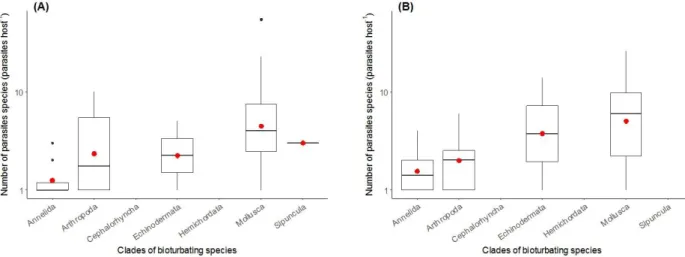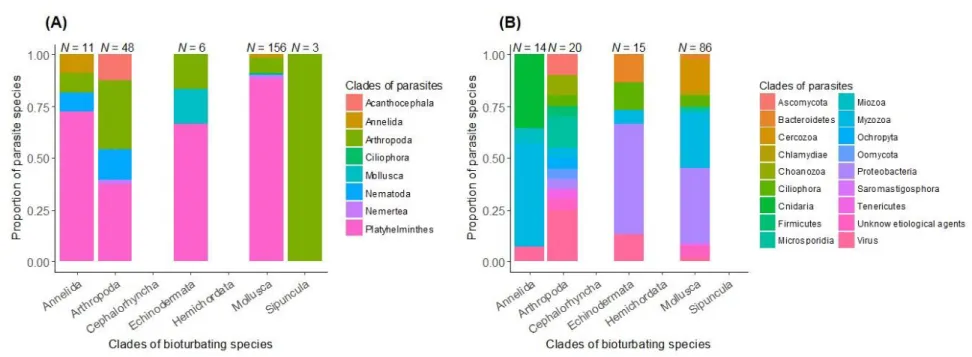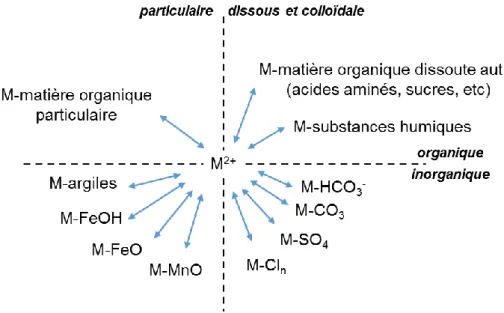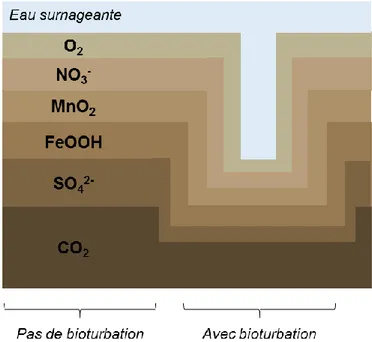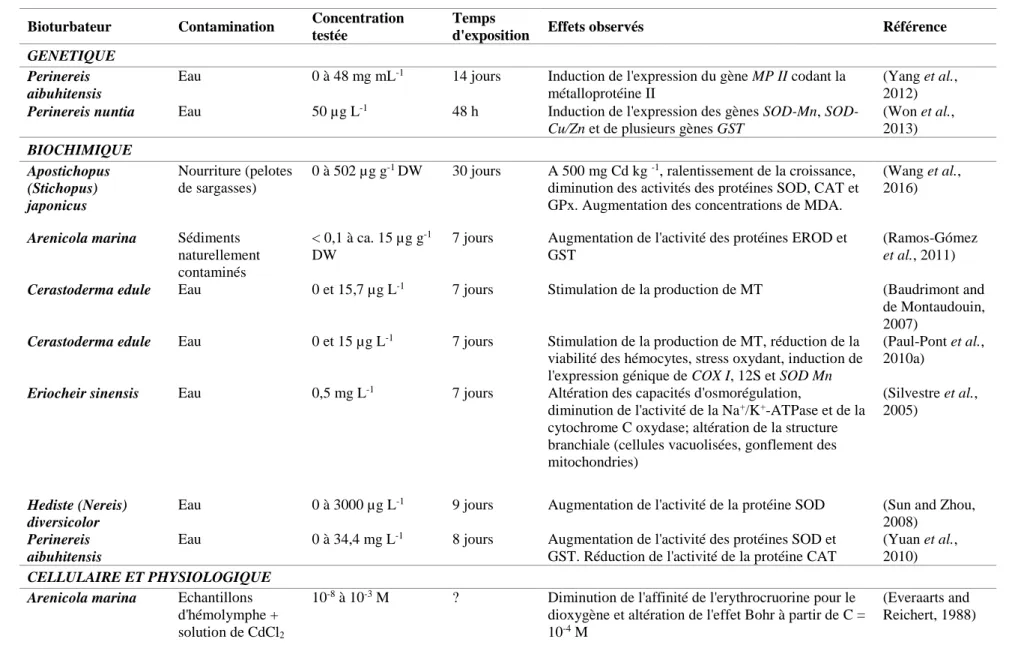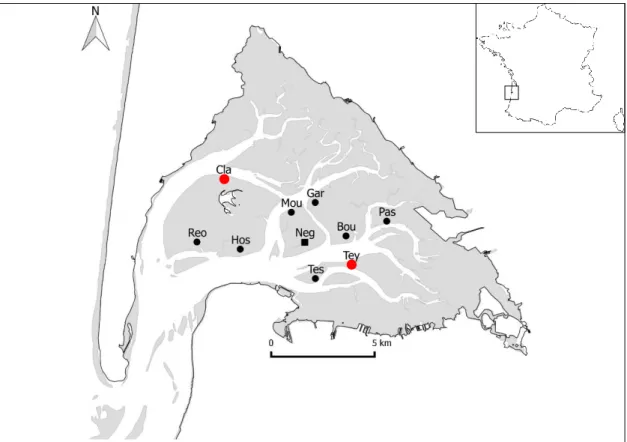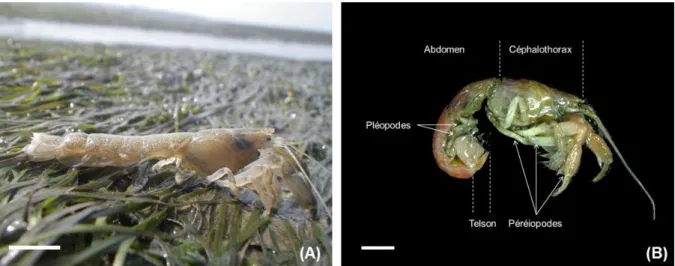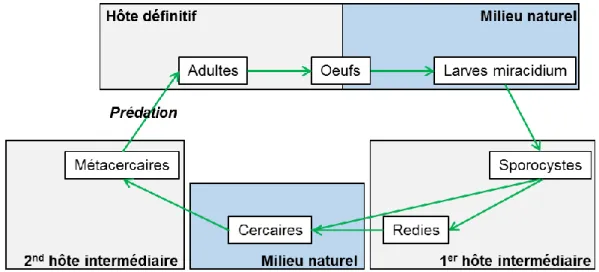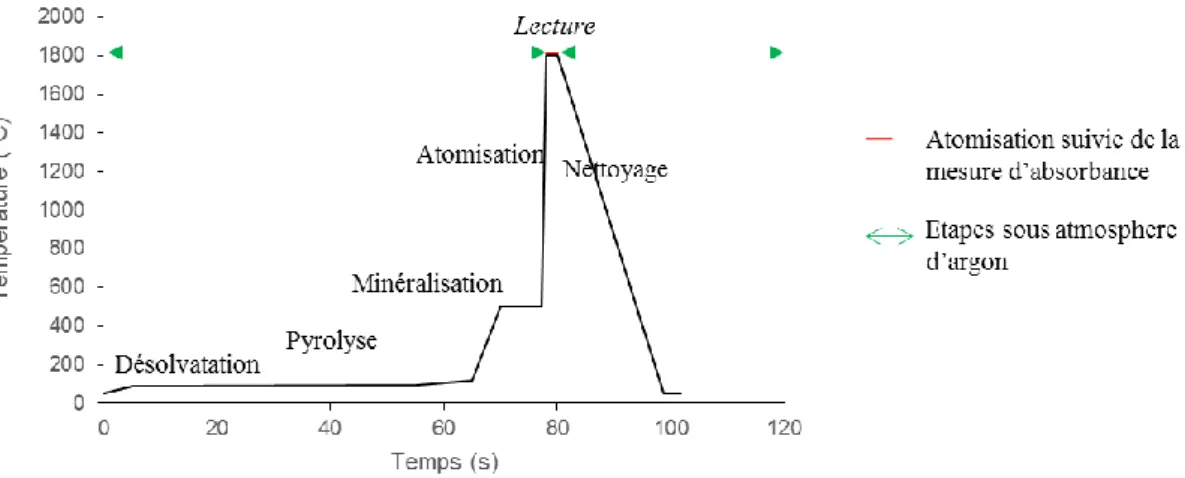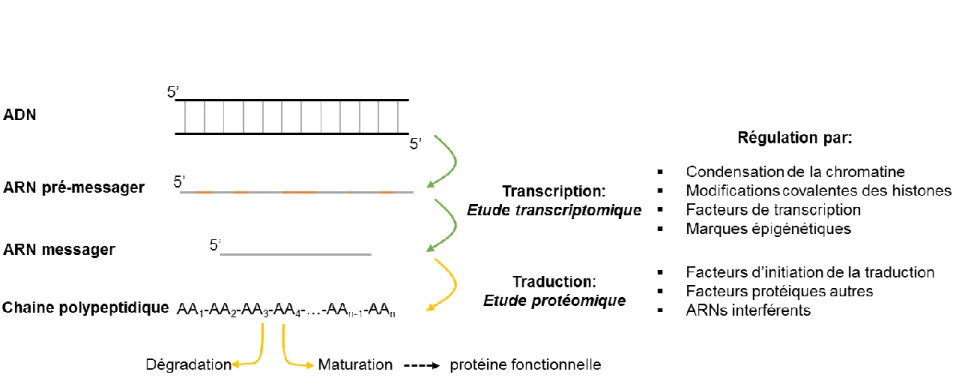HAL Id: tel-02426190
https://tel.archives-ouvertes.fr/tel-02426190
Submitted on 2 Jan 2020HAL is a multi-disciplinary open access archive for the deposit and dissemination of sci-entific research documents, whether they are pub-lished or not. The documents may come from teaching and research institutions in France or abroad, or from public or private research centers.
L’archive ouverte pluridisciplinaire HAL, est destinée au dépôt et à la diffusion de documents scientifiques de niveau recherche, publiés ou non, émanant des établissements d’enseignement et de recherche français ou étrangers, des laboratoires publics ou privés.
dans un environnement littoral soumis à différents
stress : infestations parasitaires et contamination
métallique
Annabelle Dairain
To cite this version:
Annabelle Dairain. Sensibilité de l’espèce bioturbatrice Upogebia cf. pusilla dans un environnement littoral soumis à différents stress : infestations parasitaires et contamination métallique. Biologie animale. Université de Bordeaux, 2018. Français. �NNT : 2018BORD0331�. �tel-02426190�
THÈSE PRÉSENTÉE
POUR OBTENIR LE GRADE DE
DOCTEUR DE
L’UNIVERSITÉ DE BORDEAUX
ÉCOLE DOCTORALE SCIENCES ET ENVIRONNEMENTS
SPÉCIALITÉ : Biogéochimie et écosystèmes
Par M
elleAnnabelle DAIRAIN
Sensibilité de l’espèce bioturbatrice Upogebia cf. pusilla
dans un environnement littoral soumis à différents stress :
infestations parasitaires et contamination métallique
Sous la direction de : Xavier de MONTAUDOUIN
Co-directeur : Alexia LEGEAY
Soutenue le 10 décembre 2018
Membres du jury :
Mme PERROT-MINNOT, Marie-Jeanne Maître de conférences HDR, Université de Bourgogne Rapporteur M. GEFFARD, Alain Professeur, Université de Reims Champagne-Ardenne Rapporteur M. GREMARE, Antoine Professeur, Université de Bordeaux Président M. MERMILLOD-BLONDIN, Florian Chargé de recherche HDR, CNRS Examinateur M. MAIRE, Olivier Maître de conférences, Université de Bordeaux Invité
Sensibilité de l’espèce bioturbatrice Upogebia cf. pusilla dans un
environnement littoral soumis à différents stress : infestations parasitaires et
contamination métallique
Résumé : Les processus de bioturbation constituent un exemple classique d’ingénierie de l’écosystème. Ils sont le fait d’espèces bioturbatrices qui contribuent à la structuration physique et biogéochimique des environnements sédimentaires. Dans les environnements marins meubles, les thalassinidés comptent parmi les bioturbateurs les plus influents. Ainsi, la crevette de vase Upogebia cf. pusilla est à l’origine d’un important remaniement sédimentaire et d’une large bioirrigation des sédiments dans le bassin d’Arcachon. Ces activités de bioturbation modulent les processus de minéralisation de la matière organique et les flux biogéochimiques à l’interface eau-sédiment. L’intensité de la bioturbation de U. cf. pusilla dépend de son état physiologique, celui-ci pouvant être altéré par divers facteurs de stress. Une approche couplant études de terrain et expérimentations en laboratoire a permis d’évaluer l’influence du parasitisme et de la contamination métallique sur les activités de U. cf. pusilla. Ce travail avait pour objectifs de (1) caractériser la pression parasitaire chez U. cf. pusilla à l’échelle locale, (2) déterminer les niveaux de base des éléments métalliques chez cet organisme dans le bassin d’Arcachon et d’évaluer le potentiel rôle des parasites dans les processus d’accumulation des métaux et (3) estimer l’impact du parasitisme et de la contamination métallique, seuls et en interaction, sur U. cf. pusilla et ce à deux échelles d’organisation, moléculaire et comportementale.
In situ, un suivi spatial et un suivi temporel ont permis de caractériser la dynamique spatio-temporelle de deux parasites chez U. cf. pusilla¸ un bopyre (Gyge branchialis), infestant la cavité branchiale, et un trématode (Maritrema sp.), infectant l’ensemble des organes de l’animal. Au sein de leur hôte, ces deux parasites sont négativement associés, le bopyre limitant probablement les processus d’infection par le trématode. Par ailleurs, un suivi saisonnier d’un an a permis de noter de faibles concentrations en métaux chez U. cf. pusilla, dans le bassin d’Arcachon. Ces concentrations ont été mises en parallèle avec le statut parasitaire des spécimens échantillonnés. Aucune corrélation n’a été notée entre la présence des trématodes et les quantités de métaux accumulées. A l’inverse, les observations de terrain ont permis d’envisager que le parasite bopyre puisse interférer avec les processus d’accumulation des métaux chez cet organisme. Cette dernière hypothèse a été testée en laboratoire au cours d’expérimentations visant à évaluer l’influence d’une contamination métallique (en utilisant le cadmium comme contaminant modèle) et du parasite bopyre, seuls et en interaction, sur U. cf. pusilla. A l’échelle moléculaire, le bopyre n’a été associé à aucune modification de l’expression d’une dizaine de gènes cibles. Par ailleurs, à l’échelle comportementale, ce parasite réduit peu le remaniement sédimentaire de son hôte, à l’inverse de ce qui avait été montré au cours d’une étude antérieure. En ce qui concerne l’influence du cadmium, ce métal module amplement l’expression de gènes codant notamment des protéines impliquées dans la réponse au stress oxydant et dans les mécanismes de détoxication. Ces observations suggèrent que U. cf. pusilla est capable de mettre en place des mécanismes de lutte contre le stress métallique. Au niveau comportemental, le cadmium semble stimuler le remaniement sédimentaire des organismes. Finalement, les expériences « doubles stress » ont montré un effet antagoniste du bopyre et du cadmium à la fois à l’échelle génique et à l’échelle comportementale. Ainsi, cette étude souligne la complexité des interactions entre facteurs de stress multiples et la nécessité d’effectuer de telles expérimentations. Finalement, ces travaux mettent en avant l’intérêt majeur de considérer plusieurs niveaux d’intégration au cours d’études visant à évaluer l’influence de facteurs de stress sur des organismes d’importance majeure comme les espèces ingénieures de l’écosystème.
Mots clés : crevette de vase, parasitisme, bioturbation, contamination métallique, interactions, réponse génique
UMR CNRS 5805 EPOC
Environnements et Paléoenvironnements Océaniques et Continentaux
littoral environment: parasitic infestations and metal contamination
Abstract: Bioturbation is a typical example of ecosystem engineering. Bioturbating species are mainly epi- or endobenthic organisms, which profoundly affect the physical structure and biogeochemical properties of sediments. In marine soft-bottom environments, thalassinidean mud shrimp are considered as one of the most prominent bioturbating organisms. Among these species is the mud shrimp Upogebia cf. pusilla, which is recognized as an important sediment reworker, also significantly contributing to the bioirrigation of sediments. In fine, this species greatly modulates organic matter mineralization and biogeochemical fluxes at the sediment-water interface. The influence of U. cf. pusilla in ecosystem functioning depends on the intensity of its bioturbation and thus on its fitness. Several factors can affect the physiological status of organisms, potentially resulting in behavioural changes and causing modifications of their activities. Amongst potential stressors, we evaluated the influence of parasitism and trace metal contamination on the mud shrimp U. cf. pusilla in Arcachon Bay, France. Field surveys and laboratory experiments were undertaken in order to evaluate (1) the parasite infestation levels in the mud shrimp at the local scale, (2) the metal contamination background and potential relationship between the metal accumulation and the parasitic status of organisms in the field and (3) estimate the distinct and interactive impacts of parasitism and metal contamination on two scales of organisation, by targeting a molecular (gene expression) and a behavioural (sediment reworking) endpoint.
A large spatial and temporal survey conducted in Arcachon Bay showed that at least two parasites species occur in mud shrimp: a bopyrid isopod (Gyge branchialis), living in one of the gill chambers of its host, and a trematode parasite (Maritrema sp.), infecting the whole body of mud shrimp. These two parasite species are negatively associated within their host, in which the bopyrid likely interferes with trematodes establishment. Additionally, a one year seasonal sampling demonstrated that mud shrimp displayed very low levels of metals in Arcachon Bay. The bopyrid parasite could interfere with the process of metal accumulation in mud shrimp, while such correlation was not found for the trematode parasite. Finally, complementary laboratory experiments highlighted that, at the molecular level, the bopyrid parasite did not affect the expression of the genes targeted in this study in mud shrimp. Similarly, at the behavioural level, and conversely to a previous study, the effects of the bopyrid parasite were minor, i.e. only associated to small modifications of the bioturbation activity of its host. Indeed, the intensity of the sediment reworking of mud shrimp was slightly reduced when organisms were infested with this parasite. Regarding trace metal contamination, we noticed that mud shrimp largely accumulated cadmium. This accumulation was associated to an important modulation of gene expression, especially of genes encoding proteins involved in detoxification processes, highlighting, at this organisation level, the capability of mud shrimp to deal with the deleterious effect of cadmium. At the behavioural scale, cadmium contamination positively affected the sediment reworking activity of mud shrimp. Finally, double-stress experiments evidenced an antagonistic effect of both stressors on the two targeted endpoints. This study highlights the complexity of the interactions between multiple stressors and that the response of organisms cannot be predicted from “single-stress” experiments. Moreover, this study strongly suggests to evaluate the impacts of these stressors on various levels of organisation, in particular in ecosystem engineer species such as mud shrimp, since modifications of genetic processes do not necessary prelude alterations at the behavioural level.
Keywords : mud shrimp, parasitism, bioturbation, metal contamination, interactions, gene expression
UMR CNRS 5805 EPOC
Environnements et Paléoenvironnements Océaniques et Continentaux
Avoir eu l’occasion de faire une thèse est sans doute l’expérience professionnelle la plus passionnante, stimulante, enrichissante, dévorante, stressante, et aussi quelques fois éprouvante, que j’ai eu l’occasion d’expérimenter jusqu’à présent. En un mot, j’ai trouvé cela GENIAL (et je ne le pense pas sous le coup de la fatigue post-rédaction qui liquéfie le cerveau et fait oublier tous les autres moments, parfois plus difficiles). Néanmoins, la thèse a le désavantage majeur de rendre complètement égocentrique. Pendant trois ans (voire un peu plus lorsqu’on n’est pas pressé de s’arrêter), on ne pense plus qu’à soi, oubliant un peu le monde autour de soi et en étant un peu (voire beaucoup) insupportable avec les personnes qui nous entourent, que ce soit professionnellement ou personnellement. De ce fait, je suis ravie de l’occasion qui m’est donnée de pouvoir remercier l’ensemble de ces personnes qui, de près ou de loin, ont joué un rôle dans ce travail de thèse.
Tout d’abord, je remercie vivement Mme Marie-Jeanne Perrot-Minnot et M. Alain Geffard d’avoir accepté d’être les rapporteurs de ce travail et ainsi d’en évaluer la qualité et la pertinence scientifique. Mes plus sincères remerciement vont également à M. Florian Mermillod-Blondin et M. Antoine Grémare pour avoir également accepté de juger ce travail en temps qu’examinateurs et à M. Olivier Maire d’avoir accepté d’être membre invité de ce jury.
Antoine, je vous remercie également de m’avoir accueillie au sein du laboratoire EPOC, et plus précisément à la station marine d’Arcachon, pour effectuer ce travail de thèse. Merci également de m’avoir délégué certains de vos TD, même si, la seconde année, ils m’ont fortement fait douter de mes capacités à enseigner.
Mes plus sincères remerciements vont maintenant aux deux protagonistes clefs de cette thèse : Alexia Legeay et Xavier de Montaudouin. Il paraitrait que les romains disaient des gaulois qu’il s’agissait d’un peuple de sauvages car ces derniers ne mettaient pas d’eau dans leur vin. Au sens métaphorique, je mets rarement « de l’eau dans mon vin », et on s’accordera sans doute à dire, et ce, de façon relativement objective, que j’ai un coté largement sauvage. Par conséquent, il est quand même plutôt difficile de travailler avec moi. Alexia, Xavier, je ne sais ainsi comment vous exprimer ma plus profonde gratitude, vous, qui au quotidien, avez supporté mon mauvais caractère et qui n’avez jamais failli à m’aider, m’encourager, me pousser, me conseiller, me rassurer et j’en passe.
Alexia merci pour votre confiance sans failles et vos encouragements, votre disponibilité que ce soit pour les sorties « terrain » (il faudra penser à vous trouver des gants), les dissections et bien entendu ces passionnantes sessions découpage de carottes. Le temps est passé bien plus vite à écouter toutes vos histoires. Merci également pour votre oreille attentive sur à peu près tout et n’importe quoi, quitte à parfois mélanger personnel et professionnel. Enfin, merci d’avoir veillé à mon « bien-être » au cours de ces trois années (« rentre chez toi ! », « prends des vacances ! », etc.) et ce, même si vous vous êtes parfois heurtée à un mur.
Xavier, il est difficile de dire quelque chose qui n’a pas déjà été dit par l’un (et surtout l’une) de vos précédent(e)s thésard(e)s. Je vais donc répéter ce qui a déjà été dit, mais cela n’enlève rien à la valeur de ces mots : l’étendue de vos qualités humaines et professionnelles est juste impressionnante. En vrac, merci pour votre patience, disponibilité, gentillesse, efficacité et réactivité, bienveillance, propension à partager vos connaissances et ce de manière tellement pédagogue et, finalement, votre pondération, qui n’a, parfois, pas été de trop. Je dois avouer que Patrice et moi avons ouvert les paris sur votre planète d’origine. Néanmoins, et malgré toutes ces qualités, puisque j’ai quand même eu l’occasion de vous voir une fois agacé et même vous entendre jurer (qui l’eut cru !?!), je finis par voter pour la Terre, en reconnaissant bien volontiers, que pour à peu près tout, vous êtes « l’exception qui confirme la règle ». Par ailleurs, merci à tous les deux pour toute la liberté que vous m’avez laissé, pour m’avoir permis de m’engager dans plusieurs petits projets à côté de la thèse, même si parfois je me suis un peu dispersée. Pour finir simplement, je vous remercie sincèrement de m’avoir fait confiance au cours de ces trois ans, en espérant ne pas vous avoir trop déçu.
Cette thèse, largement interdisciplinaire, a par ailleurs impliqué tout un panel de spécialistes, qui ont constitué une équipe de référents scientifiques de choc. Ainsi mille mercis (respectueux) au DOCTEUR Gonzalez ! Patrice, merci pour votre gentillesse, votre bonne humeur, votre humour, pour avoir appris à pêcher les Upogebia et avoir participé à toutes ces sorties, et pas uniquement en été ! Accessoirement
(…), merci d’avoir partagé un peu de votre savoir en biologie moléculaire, d’avoir pris le temps de répondre à toutes mes questions et pour nos discussions acclimatation/adaptation (d’ailleurs je ne suis toujours pas d’accord avec vous). Dans la partie bio mol, mes sincères remerciements vont également à Cerise Daffe. Merci pour tout Cerise, pour ton temps, tes formations, ta disponibilité, tes conseils, ta gentillesse et finalement ton amitié, quand c’était un peu plus difficile.
Dans la série « référents scientifiques », un grand merci à Olivier Maire, prédateur de Upogebia, qui pourrait décimer, à lui seul, la population du bassin. Merci pour tout Olivier : des cours accélérés « bioturbation » jusqu’au sorties improvisées « Upogebia » parce que « euh, je n’ai pas mis de couvercles et les crevettes se sont échappées », en passant par les discussions/conseils « gestion de carrière » entre deux portes. Toutes mes excuses pour avoir sali votre bateau ! mais …
J’adresse également tous mes remerciements à Magalie Baudrimont. Magalie, merci pour ton temps, toutes tes explications « ecotox » à la novice que je suis. Nous n’avons finalement pas tellement échangé, mais le peu d’entretiens que nous avons eu ont toujours permis d’éclairer de façon ultra efficace ma lanterne. Je garderai également un très bon souvenir de notre séjour à Rome, avec en tête de file Alexia guide touristique !
Dans la partie géochimie, je remercie également chaleureusement Aurélie Ciutat et Alexandra Coynel. Aurélie, merci pour avoir pris le temps de répondre à ma liste longue comme le bras de questions « méthodologie » et surtout pour ton temps passé dans le mésocosme à couper des carottes. Plus personnellement, merci pour tes conseils avisés et pour avoir répondu honnêtement à mes inquiétudes. Alexandra, merci pour ta grande disponibilité, pour avoir pris le temps de m’expliquer le point de vue des géochimistes et pour m’avoir aiguillée lorsque je me débattais avec les révisions de mon papier. Pour finir dans la partie « science », un grand merci à Pierre-Yves Gourves pour avoir passé mes nombreux échantillons à l’ICP, pour son calme olympien lorsqu’à chaque fois que je m’approchais du four celui-ci tombait en panne et pour ne pas m’avoir coupé la tête lorsque la première fois que j’ai préparé des échantillons, j’ai failli lui bousiller son ICP-OES. Merci également à Adeline Arini pour m’avoir formée sur cette maudite machine…
Egalement, merci au « grand » Docteur Pierron pour toutes nos discussions éco-évo-génétique, pour avoir répondu à mes questions Cd et surtout méthodo : top chrono, tu as 10 min pour m’expliquer en détails le principe de …
La thèse c’est de la science mais pas que, c’est également une grande et incroyable expérience humaine. Tout d’abord, merci à mes trois grands acolytes : Ludo, Nowak et bien sûr l’inimitable Lavesque. Ludo, Antoine, merci d’avoir été là jour après jour pendant trois ans ! J’ai adoré partager avec vous ce bureau, jouer au thèse pong, boire du rhum dès 16h30 dans des verres duralex, avoir des discussions philosophiques sur à peu près tout et n’importe quoi, regarder Ludo te casser les dents Antoine, etc. Merci pour votre grande patience, votre écoute et vos encouragements. Prix spécial à Ludo qui même à 4996 km arrive toujours à me remonter le moral et a sans doute été l’une de mes meilleures copines au cours de ces trois années ! Quant à Antoine, ta curiosité scientifique m’étonnera toujours, partager un bureau avec toi, c’est juste tellement stimulant : tu veux toujours tout comprendre, savoir et cela permet de se poser des questions sur ces propres connaissances. Merci également pour avoir été, au cours de cette dernière année, mon « éponge à émotions » et pour avoir été la voix de la raison, qui me manque cruellement. Finalement merci à Nico, ma grande copine de CDL : ces réunions n’auraient certainement pas eu le même piquant sans toi ! En dehors de ça, tout simplement merci d’avoir été là que ce soit pour parler science, pour « gossiper » ou pour me rassurer sur mes angoisses quelquefois ridicules.
En dehors de cette fameuse bande, une très grande pensée pour ma grande copine puis amie Sophie. Merci d’avoir été là et de m’avoir soutenue quand j’en ai eu le plus besoin. Je ne m’appesantirai pas plus, mais sache que je t’en suis sincèrement reconnaissante.
Je n’oublie évidemment pas tous les copains et collègues du labo : Cécile et sa bienveillance, ses sages conseils et sa force tranquille (désolée pour l’image), Guillaume et ses longues histoires, Alicia, jamais stressée, Marie la bisounours (merci pour ce magnifique semainier de chocolats et pour ta gentillesse si rafraichissante), Suzie dont j’adore la franchise, Hélène dont j’admire le courage, la simplicité et la bienveillance, Débora et sa joie de vivre débordante, Line et son coté si maternel, Marie-Ange pour nos discussions si matinales, Benoit pour son aide sur le terrain et finalement Hugues pour son coté pince sans rire et avec qui j’ai adoré discuter évolution humaine. Egalement un grand merci à Fred (M. Garabetian, un peu de respect voyons !) pour son humour, pour m’avoir obligée à venir aux réunions de
l’ED (mais j’ai eu gain de cause sur les transports) et pour sa bienveillance en tant que directeur de l’ED 304 mais pas que.
Pour finir, un immense merci à ma famille, au sens « dawkinien » (i.e. étendu), pour tout son soutien. En particulier, merci à mon trio de copines, les meilleures qu’on puisse imaginer. Tout d’abord Anne-Charlotte l’intellectuelle ; Anne-Cha, merci pour toute ta gentillesse, ton écoute, tes conseils si avisés, ton soutien à toute épreuve et tout simplement ton amitié. Cela a été d’un grand réconfort de traverser tout ça quasiment en même temps. Merci pour ces moments « corrections de thèse » qui m’ont permis de redécouvrir la génétique, et surtout pour me pousser à me dépasser en permanence par ton simple exemple. Ensuite, une grande pensée pour Marine l’enseignante, reine des Mojitos, de la planification et détentrice des secrets de l’EN, qui m’a « obligée » à partir en vacances, tout en acceptant de me trainer comme un boulet puisque je l’ai lâchement laissée tout organiser. Finalement, un grand merci à Astrid l’épicurienne, la meilleure formatrice qu’on puisse imaginer sur le thème « apprendre à profiter de la vie en 10 leçons ». J’arrive à bout de qualificatifs pour vous exprimer toute ma reconnaissance à toutes les trois d’avoir été là, tout simplement.
Mes derniers mots iront à mes parents. Merci Papa et Cathy pour m’avoir encouragée, même si ça n’a été qu’au cours des dernières années, mon premier plan de carrière ne vous enthousiasmant pas trop. Merci à ma « petite » sœur, qui ne comprend rien à ce que je fais mais essaie toujours de s’intéresser quand j’en parle. Déborah, j’espère sincèrement que tu finiras par te lancer toi aussi. Finalement, rien de ce que je ne saurais écrire ne permettrait d’exprimer à quel point je suis reconnaissante à ma mère pour TOUT ce qu’elle a fait pour moi, pour tout son soutien, toujours, malgré tout et surtout malgré moi. Merci pour ta confiance, pour me considérer comme ton égale (d’où mes soucis avec la hiérarchie maintenant) et pour ton éducation qui pourrait se résumer à ces mots que je n’ai que trop entendus quand je te demandais de l’aide : «ma chérie, mais comment feras-tu si tu étais toute seule dans le désert ? ». Tout ce que je suis capable de faire maintenant (comme cette thèse), c’est en très grande partie grâce à toi, et j’espère que ces quelques mots te le rappelleront.
SOMMAIRE
PREAMBULE ET PLAN DE LA THESE ... 15
Chapitre I. Introduction générale: parasitisme, contamination métallique et
bioturbation en milieu marin ... 17
Chapitre I-A. Influence of parasitism on bioturbation: from host to ecosystem
functioning ... 19
I. Introduction ... 23
II. Methods ... 26
II.1. Type of bioturbators ... 26
II.2. Type of parasites ... 26
III. Results and discussion ... 27
III.1. Bioturbating species in coastal environments ... 27
III.2. Number of parasites species infesting bioturbating organisms ... 27
III.3. Clades of parasites infesting bioturbating species ... 29
III.4. Effects of parasites on bioturbating species ... 31
III.5. Influence of parasites on bioturbation activity and ecosystem functioning ... 37
IV. Conclusion ... 41
Chapitre I-B. Contamination métallique en milieu aquatique, rôles de la bioturbation
et impacts sur les espèces bioturbatrices ... 43
I. Contamination métallique en milieu marin ... 45
I.1. Définition des éléments métalliques ... 45
I.2. Apports des éléments métalliques dans les zones côtières ... 45
I.3. Devenir des éléments métalliques en milieu marin ... 47
II. Bioturbation et remobilisation des éléments métalliques ... 51
III. Sensibilité des organismes bioturbateurs à la contamination métallique ... 55
III.1. Prise en charge des éléments métalliques ... 55
III.2. Mécanismes de séquestration et de détoxication ... 57
III.3. Effets de la contamination métallique sur les espèces bioturbatrices ... 59
BILAN DU CHAPITRE I ... 65
Chapitre II. Modèle d'étude et bases méthodologiques ... 67
I. Sites d’étude et modèle biologique ... 69
I.1. Zone d’étude : le bassin d’Arcachon ... 69
I.2. Modèle d’étude : les thalassinidés et l’espèce Upogebia pusilla ... 72
I.3. Le parasitisme chez Upogebia pusilla ... 75
II. Protocole de traitement des échantillons et méthodologie ... 81
II.1. Protocole général de traitement des échantillons biologiques ... 81
II.2. Quantification de la charge parasitaire en trématodes ... 81
II.3. Quantification des éléments métalliques ... 82
II.4. Techniques de biologie moléculaire ... 86
II.5. Quantification du remaniement sédimentaire... 103
Chapitre III. Pression parasitaire et contamination métallique chez Upogebia
cf. pusilla : caractérisation de la population du bassin d'Arcachon ... 107
Chapitre III-A. Parasite interactions in the bioturbator Upogebia cf. pusilla (Decapoda:
Gebiidae): a case of amensalism? ... 109
I. Introduction ... 113
II. Materials and Methods... 115
II.1. Biology of Upogebia cf. pusilla ... 115
II.2. Study sites and sampling procedure ... 115
II.3. Dissection and macroscopic analysis ... 116
II.4. Trematode identification ... 117
II.5. Data analysis ... 117
III. Results ... 118
III.1. Molecular identification of trematodes from Upogebia cf. pusilla ... 118
III.2. Distribution of Maritrema sp. metacercariae in Upogebia cf. pusilla ... 118
III.3. Temporal survey ... 121
III.4. Spatial survey ... 122
IV. Discussion ... 123
BILAN DU CHAPITRE III-A ET PERSPECTIVES ... 127
Chapitre III-B. Relationships between metal content and parasitic pressure in the
bioturbating mud shrimp Upogebia cf. pusilla: a field survey ... 129
I. Introduction ... 133
II. Materials and methods ... 135
II.1. Biology of Upogebia cf. pusilla and its parasites ... 135
II.2. Study sites and sampling strategy ... 136
II.3. Dissection ... 137
II.4. Quantification of metals in biological samples ... 137
II.5. Quantification of metals in sediments samples ... 138
II.6. Gene expression ... 138
II.7. Statistical analysis ... 139
III. Results ... 140
III.1. Trematode infection and the influence of the bopyrid parasite ... 140
III.2. Concentrations of metals in the sediment ... 141
III.3. Concentrations of metals in mud shrimp and influence of parasitism ... 142
III.4. Gene expression ... 148
III.5. Factor analysis for mixed data ... 154
IV. Discussion ... 154
IV.1. Trematode infection and influence of the bopyrid isopod ... 154
IV.2. Concentrations of metals in sediments ... 155
IV.3. Metals in mud shrimp ... 155
IV.4. Gene expression: responses to stressors ... 159
V. Conclusion ... 161
BILAN DU CHAPITRE III-B ET PERSPECTIVES ... 165
Chapitre IV. Impact de la bioturbation de Upogebia cf. pusilla dans un
environnement pollué et interférence avec le parasitisme: approche ex-situ
... 169
I. Introduction ... 175
II. Materials and methods ... 177
II.1. Biology of Upogebia cf. pusilla ... 177
II.2. Sampling of Upogebia cf. pusilla and sediment ... 178
II.4. Experimental design and setup... 178
II.5. Sampling procedure ... 179
II.6. Metal determination in sediments ... 180
II.7. Dissection ... 180
II.8. Metal determination in biological samples ... 181
II.9. Gene expression ... 181
II.10. Statistical analyses ... 183
III. Results ... 184
III.1. Physicochemical parameters ... 184
III.2. Turbidity ... 184
III.3. Cadmium transfers from the sediment to the overlying water ... 187
III.4. Vertical profiles of cadmium concentrations in the sediment ... 188
III.5. Volume of burrow ... 188
III.6. Cadmium bioaccumulation ... 190
III.7. Gene expression ... 191
IV. Discussion ... 192
IV.1. Dynamics of cadmium ... 192
IV.2. Bioaccumulation of cadmium ... 195
IV.3. Influence of parasitism ... 195
IV.4. Gene expression ... 196
V. Conclusion ... 198
BILAN DU CHAPITRE IV ET PERSPECTIVES ... 201
Chapitre V. Influence d'une contamination métallique et d'un stress
parasitaire sur la physiologie et l'activité de bioturbation de Upogebia cf.
pusilla : approche ex-situ ... 203
Chapitre V-A. Do trace metal contamination and parasitism influence the activities of
the bioturbating mud shrimp Upogebia cf. pusilla? ... 205
I. Introduction ... 209
II. Materials and methods ... 211
II.1. Sampling of Upogebia cf. pusilla and sediments ... 211
II.2. Experiment design and setup ... 212
II.3. Sediment reworking ... 213
II.4. Dissection ... 213
II.5. Metal determination in biological samples ... 214
II.6. Gene expression ... 214
II.7. Statistical analysis ... 215
III. Results ... 216
III.1. Physicochemical parameters ... 216
III.2. Bioaccumulation of cadmium ... 216
III.3. Sediment reworking ... 219
III.4. Gene expression ... 221
IV. Discussion ... 223
IV.1. Cadmium bioaccumulation and influence of parasitism ... 224
IV.2. Influence of Cd contamination and parasitism on sediment reworking activity ... 225
IV.3. Influence of contamination and parasitism on gene expression ... 227
V. Conclusion ... 231
Chapitre V-B. How does the bopyrid isopod Gyge branchialis interfere with trace metal
bioaccumulation in the mud shrimp Upogebia cf. pusilla? ... 237
I. Introduction ... 241
II. Materials and Methods... 241
II.1. The host-parasite association ... 242
II.2. Trace metal bioaccumulation in the bopyrid parasite ... 242
II.3. Influence of the bopyrid parasite on the mud shrimp’s gills ... 242
III. Results and discussion ... 245
III.1. Trace metal bioaccumulation in the female bopyrid parasite ... 245
III.2. Effect of the bopyrid parasite on the gills of mud shrimp... 245
IV. Conclusion ... 246
BILAN DU CHAPITRE V-B ET PERSPECTIVES... 249
Chapitre VI. Discussion générale et perspectives de recherche ... 251
I. Interactions parasitaires chez Upogebia cf. pusilla ... 254
II. Impacts du trematode Maritrema sp. ? ... 255
III. Impacts du bopyre Gyge branchialis ... 257
III.1. Au niveau génétique ... 257
III.2. Au niveau physiologique ... 259
III.3. Au niveau comportemental ... 260
Annexes ... 267
Influence of parasitism on bioturbation: from host to ecosystem functioning ... 269
Appendix 1 ... 271
Appendix 2 ... 278
Appendix 3 ... 307
Parasite interactions in the bioturbator Upogebia pusilla (Decapoda: Gebiidae): a case
of amensalism? ... 323
Appendix 4 ... 325
Relationships between metal content and parasitic pressure in the bioturbating mud
shrimp Upogebia cf. pusilla: a field survey ... 327
Appendix 5 ... 329
Appendix 6 ... 331
Appendix 7 ... 332
Influence of the bioturbator Upogebia cf. pusilla on trace metal remobilization: Does
parasitism matter? ... 333
Appendix 8 ... 335
Do trace metal contamination and parasitism influence the activities of the bioturbating
mud shrimp Upogebia cf. pusilla? ... 337
Appendix 9 ... 339
Le fonctionnement d’un écosystème dépend en partie des interactions entre organismes peuplant cet écosystème (interactions intra- et interspécifiques) ainsi que des interactions entre les organismes et leur environnement. Certains organismes jouent un rôle prépondérant dans le fonctionnement des écosystèmes par leur rôle dans la création, la modification et le maintien des habitats, et de ce fait influencent la disponibilité des ressources pour les autres organismes. Ce concept fut formellement défini par Jones et al. en 1994 sous le terme « d’ingénierie de l’écosystème » et les organismes initiant de tels processus nommés « espèces ingénieures de l’écosystème ». Il existe deux catégories d’espèces ingénieures de l’écosystème dites « autogènes », lorsque les processus d’ingénierie ne sont dus qu’à la simple présence de ces organismes, et « allogènes » lorsque ces processus sont liés à l’activité de ces espèces. De cette définition sont exclues les espèces dites « clefs » (Paine, 1969) dont l’importance dans le fonctionnement des écosystèmes est en lien avec des relations uniquement trophiques (proies, prédateurs) ainsi que les pollinisateurs.
Dans les écosystèmes côtiers, les processus de bioturbation constituent un archétype d’ingénierie de l’écosystème. Sous le terme bioturbation sont regroupés l’ensemble des processus de transport affectant de façon directe ou indirecte la matrice sédimentaire (Kristensen et al., 2012). Ces processus de transport sont le fait des activités d’espèces dites bioturbatrices, constituant ainsi un exemple d’organismes ingénieurs allogènes (Jones et al., 1994). Il existe toute une variété d’organismes bioturbateurs allant des gros mammifères marins jusqu’aux invertébrés benthiques, en passant par les chondrichthyens (Cadée, 2001). Classiquement, les études de bioturbation portent néanmoins sur les organismes epi- ou endobenthiques.
Le rôle joué par les espèces bioturbatrices dans le fonctionnement des écosystèmes dépend de l’intensité de leurs activités, elles-mêmes en lien avec leur bon état de santé. De nombreux paramètres environnementaux peuvent impacter le bien-être des espèces bioturbatrices. C’est dans ce contexte général que se positionne le présent travail de thèse dont l’objectif général consistait à évaluer l’influence de deux facteurs dits « de stress » sur les activités d’une espèce bioturbatrice marine. Au cours de ces travaux, nous nous sommes ainsi consacrés à l’influence du parasitisme et de la contamination métallique sur les activités de l’espèce bioturbatrice Upogebia cf. pusilla.
Ce préambule est volontairement restreint du fait de la forme revêtue par le Chapitre I de ce manuscrit. Ce premier chapitre fera en effet office de grande introduction générale, exposant l’état de l’art et, en conclusion, la problématique générale de ce manuscrit de thèse. La première partie du Chapitre I évaluera l’état des connaissances sur les liens entre espèces bioturbatrices et parasitisme et sera présentée sous la forme d’une revue soumise à publication (Marine Ecology Progress Series, Chapitre I-A). Ce sujet a pour le moment fait l’objet d’un nombre très restreint d’études et il nous est apparu nécessaire et intéressant d’en faire un état des lieux relativement exhaustif. La seconde partie de
ce premier chapitre sera consacrée aux liens entre espèces bioturbatrices et contaminants métalliques (Chapitre I-B). Les études portant sur ce dernier sujet sont comparativement plus nombreuses et ont déjà fait l’objet de revues ; ce sujet sera donc traité sous la forme d’un état des lieux plus « classique ». Dans un second temps (Chapitre II) nous nous attacherons à décrire le modèle d’étude (U. cf. pusilla), le site d’étude choisi dans le cadre des études descriptives (i.e. le bassin d’Arcachon) ainsi que les méthodes analytiques utilisées.
Le Chapitre III sera consacré à la caractérisation des stress parasitaires et métalliques expérimentés par U. cf. pusilla à l’échelle locale. Ce chapitre sera divisé en deux sous-parties, la première traitant de la pression parasitaire et la seconde de la contamination métallique à l’échelle locale en lien avec le statut parasitaire des organismes. Ces travaux seront présentés sous la forme de deux articles, le premier publié (Marine Biology, Chapitre III-A) et le second en préparation (Chapitre III-B). Ce chapitre sera suivi d’un bilan en français permettant l’introduction des études expérimentales menées dans les Chapitres IV et V.
Le Chapitre IV évaluera l’influence du parasitisme sur les capacités de remobilisation d’un contaminant modèle (le cadmium) par U. cf. pusilla. Les travaux de ce chapitre seront présentés sous la forme d’un article publié (Marine Environmental Research). Ce chapitre sera également suivi d’un bilan en français et permettra l’introduction du chapitre suivant.
Le Chapitre V s’attachera, dans un premier temps, à évaluer l’influence du parasitisme et d’une contamination métallique via l’eau sur l’activité de bioturbation de U. cf. pusilla. La seconde partie du Chapitre V sera consacrée à un approfondissement des effets du parasitisme sur la physiologie de l’hôte au cours des processus de contamination métallique. Ces travaux seront également présentés sous la forme d’un article publié (Aquatic Toxicology, Chapitre V-A) et d’une note en révision (Parasitology
Research, Chapitre V-B).
Une discussion générale (Chapitre VI) clôturera ce manuscrit et proposera des perspectives de recherche dans la continuité des travaux présentés.
CHAPITRE I
Introduction générale : parasitisme, contamination
métallique et bioturbation en milieu marin
CHAPITRE I – A
Influence of parasitism on bioturbation: from host to ecosystem
functioning
DAIRAIN A., LEGEAY A. and de MONTAUDOUIN X.
Submitted in Marine Ecology Progress Series
Abstract
Bioturbating species represent a typical example of ecosystem engineer species in aquatic environments. These abundant endo- or epibenthic organisms modify the physical structure and geochemical properties of sediments, and at broader ecosystem scale impact nutrient flows and structure benthic communities. The ecological importance of bioturbators depends on the magnitude of their bioturbation activity. We suggest that parasitism has a substantial impact on bioturbators, and cascading effects on their role in ecosystem functioning. Reviewing 5940 papers concerning bioturbation, we identified 176 bioturbating species, with 31 % of these potentially parasitized (micro- and macroparasites). However, there is significant discrepancy in the research effort on parasites among bioturbating groups, the highest effort being devoted to molluscs with studies on annelids and arthropods rare. Furthermore, studies addressing parasites’ impacts on their bioturbating hosts are still scarce, but evidence we do have indicates that parasites fundamentally impair their hosts’ physiological state, fecundity, behaviour and survival. Because of impacts of parasites on phenotypic traits related to the bioturbation engineering activity of their hosts, cascading effects of parasitism could play a key role on ecosystem functioning through cascade effects. Yet, studies assessing the intricate link between parasites and their hosts’ bioturbation activity, including potential effects on ecosystem functioning, are virtually non-existent.
I. Introduction
The structure and dynamics of ecosystems are shaped by myriad ecological and environmental parameters, an important one of which is the activity of organisms in these ecosystems. In 1994,
Jones
et al.
proposed the concept of ecosystem engineer species (EES) as an acknowledgment of the major role of some organisms in the functioning of ecosystems. The authors defined EES as species that modify their physical environment by their activity (allogenic engineers) or by their mere presence (autogenic engineers) in addition to their potential contribution to biotic interactions. EES differ from keystone species, which are defined as species occupying a significant place in a given food web (Paine, 1969). The case of beavers building dams is probably one the most striking examples of EES. This physical EES plays a key role in the structure of streams and in the functioning of their riparian zones. Indeed, dams have a marked effect on water current velocity in streams, but they also modify stream geomorphology, and retention of sediment particles and organic matter in upstream ponds, affecting biogeochemical pathways (Naiman et al., 1986, 1988). As a consequence, beavers also indirectly impact other organisms and influence the structure of natural communities. For instance, beaver-modified and un-modified areas exhibit highly distinct assemblages of plant and invertebrates species, without any large dissimilarity in species richness between modified and un-modified areas (McDowell and Naiman, 1986; Wright et al., 2002). Thus, by enhancing the landscape heterogeneity, beavers increase the gamma diversity of these systems (Whittaker, 1972).There is a broad diversity of EES inhabiting various environments (Jones et al., 1994). In marine benthic ecosystems, the role of bioturbating species as EES is well established (e.g., Krantzberg, 1985; Levinton, 1995; Lohrer et al., 2004; Mermillod-Blondin and Rosenberg, 2006; Meysman et al., 2006). The process of bioturbation is described as any modification of the sediment matrix, including interstitial waters, due to the activities of organisms living mainly in or on the substratum (Kristensen et al., 2012). The locomotory, feeding and burrowing activities of bioturbators substantially displace sediment particles. These sediment reworking activities deeply affect the physical properties and geomorphology of sediments (e.g., Rhoads and Young, 1970; Jones and Jago, 1993; Volkenborn et al., 2007a). Bioturbators also significantly enhance the transport of water in sediments. This water input stimulates movements of solutes between pore- and overlying waters, a process named bioirrigation (Kristensen et
al., 2012). In particular, sediment-dwelling organisms largely stimulate hydrological fluxes (Aller,
1988; Volkenborn et al., 2012a), since biogenic structures, such as burrows, increase the surface of solute exchanges between the sediment and the overlying and porewaters. Thus, bioturbators play a key role in the biogeochemistry of sediments (e.g., Aller, 1982; Webb and Eyre, 2004a; Volkenborn et al., 2007a, 2012a). The processes of sediment reworking and bioirrigation are highly intricate. Sediment reworking causes modifications of the texture of sediments (i.e. their permeability, porosity, and geomorphology), while the processes of bioirrigation rely on water penetration in sediments, which depends on their texture (Huettel and Gust, 1992; Volkenborn et al., 2007b). Finally, as a consequence
of their large impact on the physical and geochemical properties of benthic habitats, bioturbators exert a major influence on other organisms and drive the composition of benthic communities (e.g., Dahlgren
et al., 1999; Widdicombe et al., 2000; Papaspyrou et al., 2005; Pillay et al., 2007; Brustolin et al., 2016).
As an illustration, an exclusion experiment highlighted the large impact of the bioturbating mud shrimp
Callichirus (Callianassa) kraussi on benthic communities. Mud shrimp presence was associated with
lower species abundance, richness and diversity of benthic organisms compared to areas without the shrimp. However, the influence that mud shrimp had depended on the guild benthic animals belonged to, as burying infauna were less affected by mud shrimp than surfacing organisms. The effect of C.
kraussi on the benthic community could be related to the negative influence of bioturbation on
development of biofilms upon which epifauna feed (Pillay et al., 2007).
The influence of bioturbators as EES depends on the magnitude of their activities and thus on the physiological state of these organisms. In natural environments, organisms are seldom in optimal environmental conditions and different abiotic and biotic factors can adversely affect the physiology and the behaviour of bioturbating organisms, altering ecosystem functioning through cascade effects. The role of environmental factors such as temperature, salinity and food availability is well established (e.g., Berkenbusch and Rowden, 1999; Ouellette et al., 2004; Przeslawski et al., 2009). For instance, bioturbation activity of the bivalve Abra segmentum (ovata) varies with temperature, organisms burrowing deeper and reworking a larger sediment surface when exposed to warm than to cold temperatures (Maire et al., 2007b). Oxygen availability has also been shown to significantly affect the behaviour of organisms. Under hypoxic conditions, bioturbators burry shallower and build smaller burrows, reduce the ventilation of their burrow and even emerge at the sediment-water interface (Diaz and Rosenberg, 1995; Sturdivant et al., 2012; Murray et al., 2017). Such behaviour modifications affect the performance of bioturbators as EES. Biotic interactions can also have a large influence on the individual behaviour of organisms and could play a key role in bioturbation processes (Braeckman et
al., 2010; Maire et al., 2010; Premo and Tyler, 2013; Campbell and Lindsay, 2014). For instance,
interspecific interactions could change the magnitude of bioturbation activities via alterations of animal behaviour or injuries to bioturbating organisms (Maire et al., 2010; Premo and Tyler, 2013; Campbell and Lindsay, 2014). In response to the presence of its predatory shrimp Crangon crangon, the clam
Limecola (Macoma) balthica buries deeper into the sediment, thereby increasing the thickness of the
bioturbated layer (Maire et al., 2010). In contrast, the effect of the bioturbator Tritia (Ilyanassa) obsoleta on ammonium fluxes at the sediment-water interface is largely reduced when this gastropod is threatened by its predator, the mud crab Panopeus herbstii (Premo and Tyler, 2013).
Among biotic parameters influencing faunal EES, one major concern is the role played by parasites and associated infectious diseases. In the context of global climate change, it has been suggested that warmer conditions could increase the frequency and intensity of disease events (Marcogliese, 2001; Harvell et
Maritrema novaezealandense in the amphipod host Paracalliope novizealandiae. A larger parasite
burden is associated with a higher mortality rate of amphipods (Studer and Poulin, 2013). Although many parasites and associated infectious diseases can produce mass mortality events in host populations (e.g., Jensen and Mouritsen, 1992; Jonsson and Andé, 1992; Fredensborg et al., 2004), parasites can also have a wide range of sub-lethal effects, especially on the physiological status and behaviour of infested organisms. For example, the health of parasitized organisms is often impaired as reflected in reduced growth rate and condition index (e.g., Thieltges, 2006; Dang et al., 2013; O’Connell-Milne et
al., 2016). This pattern could be due to parasites directly interfering with food uptake (Flye-Sainte-Marie et al., 2007; Stier et al., 2015) or impairing a host’s metabolism (Anderson, 1977; Repetto and Griffen,
2012). In contrast, some parasites stimulate the growth of hosts, leading to cases of “gigantism” (Pearre, 1976; Sluiters et al., 1980; Mouritsen and Jensen, 1994). For example, mud snails Peringia (Hydrobia)
ulvae infected with larval trematodes grow more rapidly than unparasitized organisms. This pattern is
likely due to a reallocation of energy since the faster growth rate of parasitized organisms is not correlated with increased food uptake, and locomotor activity and reproductive process are both impaired in parasitized organisms (Mouritsen and Jensen, 1994). Behaviour modifications can also result from parasitism, with infested organisms being moribund or exhibiting aberrant behaviour compared to unparasitized individuals (e.g., Thomas and Poulin, 1998; Vicente et al., 2012; Pascal, 2017). Overall, it is usually assumed that parasites and associated infectious diseases have debilitating effects on their hosts, with infested organisms in poorer conditions than uninfested individuals. These effects of parasites on individual host organisms can produce broad impacts at the ecosystem level, with parasites playing a key role in structuring communities of free-living organisms for instance (Price et
al., 1986; Minchella and Scott, 1991; Poulin, 1999; Mouritsen and Poulin, 2002).
Regarding bioturbating species as EES, parasites and associated infectious diseases could (1) impair the physiological state of their host and thus the intensity of their bioturbation activity and/or (2) modify behaviours related to the bioturbation activity of their host. Thus, parasites could alter the influence bioturbating species have on the physical structure of sediments, in biogeochemical cycles and on the regulation of the community structure of organisms. Considering the major potential role of parasites on such important EES, it seems reasonable to investigate the influence of this stressor on bioturbators. The aim of this paper is to review current knowledge on parasites and associated infectious diseases in common bioturbators and present a general framework for future studies. We examined the relationship between parasites and bioturbators by answering four questions: (1) what are the commonly studied bioturbating species, (2) are there any parasites known to infest bioturbating species, (3) what are the effects of parasites on their host and do they modify the intensity of their bioturbation activity, and (4) do parasites infesting bioturbating species have any consequence on the functioning of ecosystems?
II. Methods
II.1. Type of bioturbators
In this study, bioturbating species were restricted to epi- or endobenthic faunal organisms influencing the physical structure (i.e. grain size, porosity, organic matter content, etc.) and/or biogeochemical properties (i.e. nutrient and solute contents, redox status, etc.) of sediments. Therefore, only studies evaluating and quantifying the influence of organisms on the sediment structure and/or in biogeochemical processes were taken into account. In addition, this literature review was limited to invertebrates occurring in coastal environments, including mangrove forests. Taking these restrictions into account, publications were searched in Scopus using the terms “bioturbation”, “sediment reworking” and “bioirrigation”. Because of the very high number of related papers, the search was further constrained to publications belonging to the “environmental science” subject area for the items “sediment reworking” and “bioirrigation”. A list of 4912, 732 and 296 publications for the terms “bioturbation”, “sediment reworking” and “bioirrigation” were gathered (May 11th, 2018), respectively. Bioturbators were taxonomically classified based on the World Register of Marine Species (WoRMS Editorial Board, 2018).
II.2. Type of parasites
Parasites were broadly defined as organisms living with benefits on (ectoparasites) or in (endo- and mesoparasites) another organism (the host), on which they have a detrimental impact (Combes, 1995). By extension, we included viruses as parasitic organisms (Combes, 1995). This study investigated both microparasites (unicellular organisms like protozoans, bacteria and viruses) and macroparasites (mainly organisms belonging to helminth and arthropod groups) of bioturbating species (Anderson and May, 1979). Helminths can also be classified as microparasites depending on which stage of their life cycle is considered (i.e. rediae and sporocysts stages). However, for simplicity, we categorized helminths as macroparasites regardless of their life stage. For each of the bioturbating species identified in our first search, a second search for publications mentioning parasites occurring in these organisms was made by using the name of the bioturbating species in combination with the terms “parasite”, “infection”, “bacteria” and “virus”. In addition, we collected data related to prevalence, intensity and/or abundance of parasitic infections when available. In a sampled population, prevalence is defined as the percentage of infested individuals, intensity of infestation as the mean number of parasites per parasitized hosts, and abundance as the mean number of parasites per potential host (including both parasite-infested and uninfested) (Margolis et al., 1982). Furthermore, the influence of parasites on the physiological state, behaviour and bioturbating activity of their host was also recorded at that time. The term infestation is used for ectoparasites and the term infection for endoparasites.
III. Results and discussion
III.1. Bioturbating species in coastal environments
Our search found a total of 176 bioturbating species to be reported in coastal environments worldwide (Figure I-A. 1; see Appendix 1 for a full list of the bioturbators). Species belonging to the phyla Arthropoda, Annelida and Mollusca were the most extensively studied, representing 37, 27 and 23 % of the total number of bioturbators, respectively (Figure I-A. 1).
Figure I-A. 1 Number of coastal bioturbating species commonly studied and number of parasitized bioturbators per taxonomic clade. Parasitized bioturbators are categorized as being infested with macroparasites, microparasites or both groups of parasites.
III.2. Number of parasites species infesting bioturbating organisms
Of the 176 species of bioturbators identified, 55 species (i.e. 31 %) were parasitized with at least one macro- or microparasite species (Figure I-A. 1). More specifically, 44 (i.e. 25 %) and 28 (i.e. 16 %) bioturbating species are infected with a least one macro- or microparasite species, respectively and 17 bioturbators (i.e 10 %) with both macro- and microparasites (Figure I-A. 1; see Appendix 2 and Appendix 3, respectively, for a full list of macro- and microparasites of bioturbating species). There is an important disparity regarding the distribution of parasites across the phyla of bioturbators, with some known to be highly parasitized, such as molluscs (51 % of the species harboring at least one parasite species), with others less frequently documented as being parasitized, for example echinoderms (22 %) and arthropods (23 %) (Figure I-A. 1). Similarly, the number of parasite species identified per bioturbating host strongly differed among phyla (Figure I-A. 2). Numerous studies were devoted to bioturbating molluscs and highlighted they were diversely parasitized, with on average (± SE) 8.2 ± 2.9 macroparasite species (Figure I-A. 2A) and 8.6 ± 2.8 microparasite species (Figure I-A. 2B) identified
per individual species. To the contrary, only a few parasites species have been documented in annelids, with on average 1.4 ± 0.3 macroparasite species (Figure I-A. 2A) and 1.8 ± 0.4 microparasite species (Figure I-A. 2B) identified per annelid species. Finally, there was also a large variability in parasite species richness per bioturbating species within a given phylum (Figure I-A. 2). For example, the number of macro- and microparasites identified in molluscan bioturbators ranged from 1–55 and 1–26, respectively (Appendix 2 and Appendix 3).
Figure I-A. 2 Number (logarithmic scale) of (A) macroparasites and (B) microparasites identified per
bioturbating species. Bioturbators are classified according to their taxonomic clade. The boxes represent the interquartile range, the black lines the median and the red dots the mean number of parasites species in each clade of bioturbators.
Several factors could explain the discrepancy in parasite species richness recorded among and within the phyla of bioturbators. First, through a large meta-analysis, Kamiya et al. (2014) highlighted a positive association between parasite species richness and host body size, population density and geographical range. Second, difference in sensitivity and susceptibility of bioturbating species to parasites could also explain interspecific variation in parasite species richness. For instance, the common cockle Cerastoderma edule exhibits a more diverse trematode parasite fauna than the carpet-shell clam
Ruditapes decussatus and the Manila clam R. philippinarum occurring in similar intertidal zones (Dang et al., 2009). Both R. decussartus and R. philippinarum display lower parasite abundances than C. edule
and a laboratory challenge experiment confirmed that trematode parasites more successfully infected cockles than clams. The higher resistance of clams to trematode infection could be related to stronger physical barriers presented by clam tissues (Dang et al., 2009). On the other hand, we suggest that the large disparity in parasite species richness we observed among and within phyla of bioturbators is more likely related to a bias in research effort on parasites occurring in these organisms. Parasites are ubiquitous in ecosystems, with about 40 % of known species estimated to be parasitic (Dobson et al., 2008), and all free-living species are likely to be parasitized with at least one parasite species. A large proportion of bioturbators, however, has not received any parasitological attention. This disparity in research on different groups of bioturbators could be related to their relative economic value. The higher the economic value of a species, the more intensive are the research efforts to identify any potential
pathogens or other stressors that could influence the sustainability of the production and/or the quality of the resource. For instance, numerous studies have been conducted in molluscs, a phylum of broad interest for fisheries and aquaculture, with the common cockle C. edule and the Manila clam R.
phillipinarum being two important species. Although a small proportion of echinoderms have been
described as being parasitized so far, there is a proportionally extensive literature on parasites infesting bioturbating echinoderms with a commercial value, such as the sea cucumber Apostichopus (Stichopus)
japonicus. In contrast, annelids are poorly exploited and have been rarely studied with regard to parasites
and associated infectious diseases.
III.3. Clades of parasites infesting bioturbating species
Bioturbators harbor a large diversity of macro- and microparasites species with large differences in the relative frequency among parasite phyla, some being dominant and others rarely observed (Figure I-A. 3, Appendix 2 and Appendix 3). Platyhelminthes are the most common macroparasites infecting bioturbators, with 75 % of the reported parasites species belonging to this phylum. Platyhelminthes infect molluscs, echinoderms and annelids, and to a lesser extent arthropods (Figure I-A. 3A). The phylum Platyhelminthes includes about 30,000 species (Caira and Littlewood, 2013), of which many are parasites (Dobson et al., 2008), such as members of the Trematoda or Cestoda. Moreover, it is one of the most important group of marine parasites (Rohde, 2005) and which makes it unsurprising that infections with Platyhelminthes have been noted in bioturbators to such extent. On the other hand, only a few studies highlighted the occurrence of parasitic annelids or nemerteans in bioturbators. As these two groups mainly consist of free-living organisms, they represent minor parasite groups in marine environments (Rohde, 2005). Regarding microparasites, 53 % of the species identified are eukaryotes and 36 % are bacteria. Eukaryotic microparasites encompasses a large diversity of phyla, while bacteria are mainly represented by Proteobacteria (Figure I-A. 3B). Finally, a few viral syndromes and infectious diseases for which the etiological agent has not yet been fully characterized (e.g. various neoplasias, viscera ejection syndrome, brown muscle disease; Appendix 3) have been noted in bioturbating organisms as well.
Figure I-A. 3 Taxonomic types of (A) macroparasites and (B) microparasites reported in clades of bioturbating species. The total number of parasite species
III.4. Effects of parasites on bioturbating species
From the literature survey, 376 macroparasites and 188 microparasites and associated infectious diseases were documented to parasitize 55 coastal bioturbating species. Among these parasites, the effects of a few were studied, with impacts of parasites on their host recognized in 32 % and 36 % of the studies highlighting the occurrence of macro- and microparasites (and associated infectious diseases) in bioturbating species, respectively. More than 82 % of the known impacts of macroparasites are due to Platyhelminthes (Appendix 2). Most studies on microparasites focused on Proteobacteria (36 %) and Myzozoa (30 %) (Appendix 3). These patterns are in accordance with those showing that Platyhelminthes, Proteobacteria and Myzozoa are the most commonly described macro- and microparasites in bioturbating species (Figure I-A. 3).
Even though the literature is thin on bioturbating species interacting with parasites, it seems that the impacts of parasites do appear to encompass various levels of organization. We roughly categorized impacts of parasites as alterations of physiological state (i.e. modulation of gene expression and cellular functions, initiation of inflammatory responses, tissue damages, etc.), modifications of reproductive functions (i.e. partial or total castration, changes in reproductive success, etc.), modifications of host behaviour (reduced activity levels, abnormal behaviours, etc.) and increase of the mortality rate of the host (Figure I-A. 4).
Figure I-A. 4 Impacts of macro- and microparasites on bioturbating organisms. Alterations of physiological state: parasites influencing gene expression, cellular functions, physical integrity, growth rates of the host, etc. Modifications of reproductive functions: parasites reducing or increasing their host’s fecundity, causing total or partial castration, etc. Modifications of behaviour: parasites reducing their host’s activity levels, inducing abnormal behaviours, etc. Total number of studies N = 85, of which
N = 35 studies on macroparasites and N = 47 studies on microparasites.
III.4.1. Impacts of parasites on host physiology
Numerous parasites are documented to impact the physiological state of their bioturbating host (Figure I-A. 4). Modulation of biochemical and cellular processes are used as early markers of exposure to stressors, preceding potential impacts at the organism’s level. Since the physiological condition of
bioturbators influences the role they will have on the community of organisms and on ecosystem functioning, studies evaluating the impact of parasites on the well-being of bioturbating species are of primary interest.
At the molecular scale, parasites interfere with gene regulation, thereby either up- or down-regulating their expression. For example, the trematode Himasthla elongata up-regulates the expression of several genes related to mitochondrial metabolism and oxidative responses in infected cockles C. edule. These modulations in gene expression are considered to be a molecular response to parasites causing energetic losses and oxidative stress in cockles (Paul-Pont et al., 2010a). The Proteobacteria Vibrio tapetis induces a similar genic response in C. edule, although the induction of gene expression is stronger with the macroparasite than with the microparasite (Paul-Pont et al., 2010a). It suggests that V. tapetis is less pathogenic for cockles than H. elongata. However, when cockles were experimentally infested with V.
tapetis, the bacterium caused the death of its host, highlighting the failure of C. edule to deal with the
microparasite infection (Paul-Pont et al., 2010a).
The host’s physical integrity can also be impaired by parasites since physiological alterations are concomitant with physical injuries. While developing and residing inside their host, parasites cause significant histopathological damages to host tissues (Lauckner, 1980; Robaldo et al., 1999; Carballal
et al., 2001; Dang et al., 2008). The trematode Microphallus szidati infects the hepatopancreas of the
mud crab Neohelice (Chasmagnathus) granulata. This parasite causes epithelial delamination of host hepatopancreas in addition to eliciting haemocytic infiltrations by the host (Robaldo et al., 1999). As the hepatopancreas plays a key role in nutrient absorption in crustaceans (Gibson and Barker, 1979), the damage caused by the parasite could impair the host energetics. Microparasites can also physically harm their host. As an illustration, Perkinsus spp. induce histological lesions in gills, digestive gland and gonad gland of the sand gaper clam Mya arenaria, in addition to eliciting host haemocytic infiltrations (McLaughlin and Faisal, 1998). Such tissues alterations are again expected to be energetically costly for the host, and may have direct repercussions on its fecundity and growth. In fact, a caging experiment conducted at two sites greatly impacted by perkinsosis along the northeast Atlantic coast of France demonstrated that growth rates of the bioturbators R. decussatus and R. philippinarum are significantly compromised as a result of Perkinsus spp. infections (Dang et al., 2013). Macroparasites impacting the growth of their bioturbating host have also been broadly documented (e.g., Mouritsen and Jensen, 1994; Smith et al., 2008; Pascal et al., 2016b). The mud shrimp Upogebia pusilla displays reduced size when infested with the epicaridean isopod Gyge branchialis (Pascal et al., 2016b). Contrary to the previous examples, the negative effect of the parasite is probably not related to histological lesions but to the parasite directly feeding at the expense of its host (Tucker, 1930). By doing so, the parasite strongly affects host energetics (Hughes, 1940) and consequently its physiological state (Williams and Boyko, 2012). Parasites do not always diminish their host’s growth rate. The bioturbators Peringia (Hydrobia)
